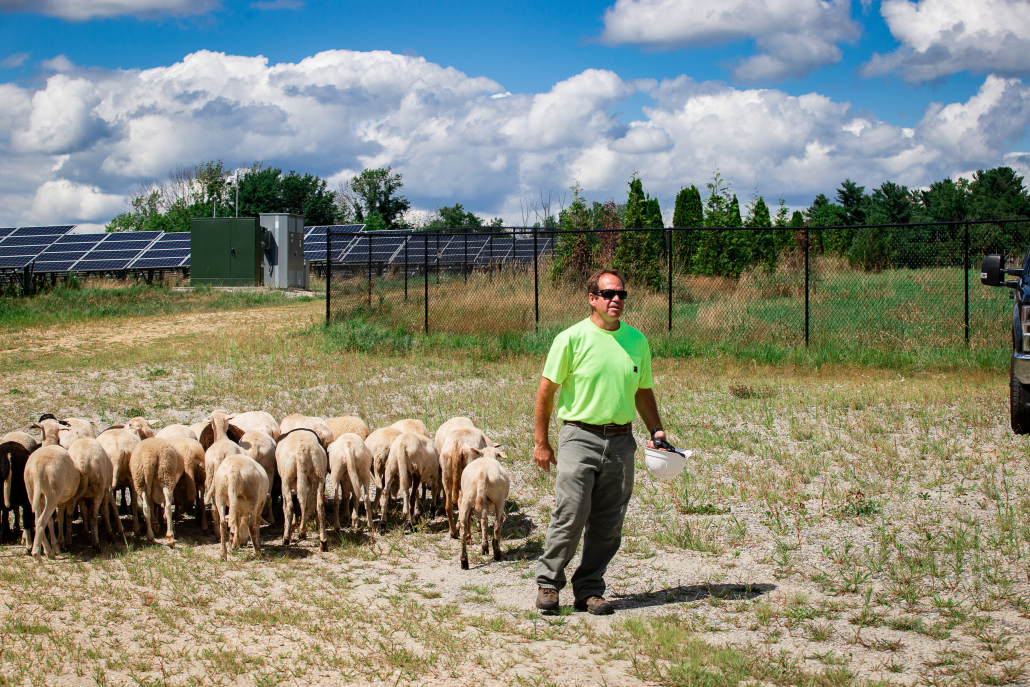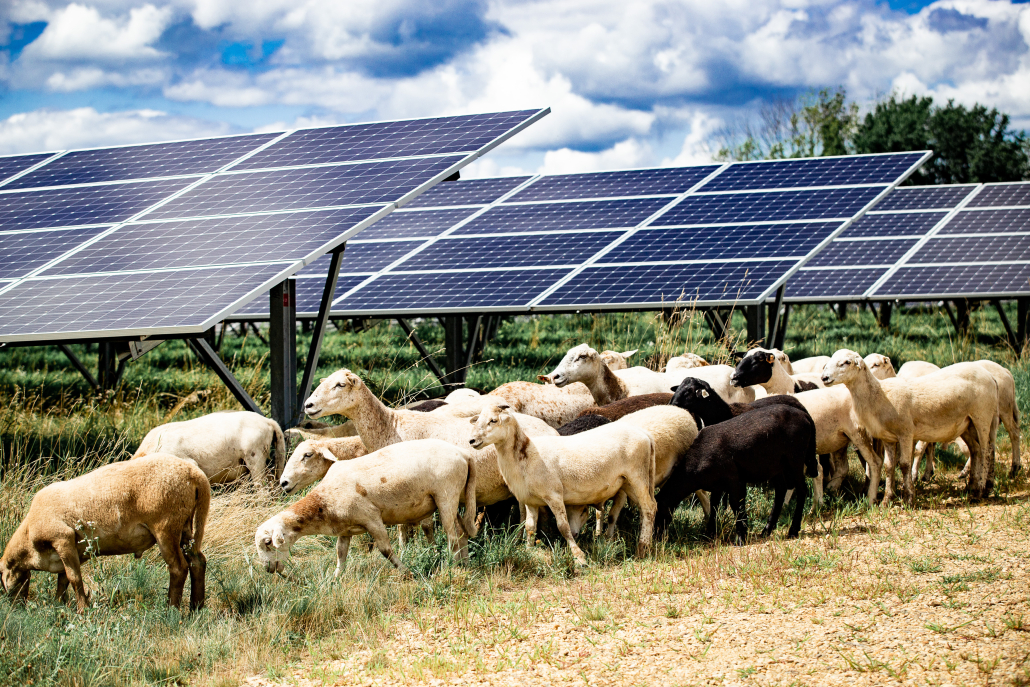By Allen Puckett, NCAT Technical Writer
July 2023
The Solar Shepherd provides grazing services in Brookfield, Massachusetts, with 75 sheep that graze a solar array site owned by SWEB Development, a European clean energy firm. This beneficial partnership was born when SWEB reached out to Solar Shepherd for grazing services after seeing their solar-grazing sites on social media. Learn more about the partnership in the AgriSolar Clearinghouse’s video How a Shepherd and Solar Developer are Joining Forces to Grow Sheep, Clean Energy.
Solar Shepherd’s founder and owner Dan Finnegan is a third- generation sheep farmer in eastern Massachusetts. His history working in a corporate environment led him to think more about what was important to him—the land, local farming, and clean energy. While he likes raising sheep, there wasn’t enough acreage for it to be profitable without agrisolar sites.

“It wouldn’t be enough to produce a living for a family,” he said. “This is more than a hobby-farming operation. With solar grazing, we dramatically expand our flock. We work hard to be competitive with landscapers on these sites. The grazing fees mitigate the costs and pay down the investment to take the show on the road (transporting sheep to solar sites). We’re used to farming out the back door, and now we have sites spread hundreds of miles apart. The grazing fees make that cost affordable.”
“I saw a solar array built on a lambing pasture, and a landscaper showed up with a tractor and started mowing up the solar arrays. He was going about 30 mph with a batwing sprayer and was mowing the rows and hosing down the panels around the arrays. I was thinking, they should just put the sheep down there and let them graze,” Dan recalled.
Solar Grazing Site Specifications and Management
The site is in a 15-acre array that produces 5 MW of DC and 3.375 MW of AC, enough to power approximately 1,100 homes. A landowner leases the land to SWEB, and SWEB hires Dan to graze the solar arrays with the sheep. The pricing is relatively the same as traditional mowing and gas-powered landscapers, but grazing sheep comes with many environmental benefits, such as enhanced landscape stabilization that directly benefits the solar companies. This stabilization includes deeper root systems on previously rocky terrain, improved turf health, and significant runoff reduction.
Solar Shepherd practices rotational grazing on their sites, which allows more carbon in the soil and retains more moisture. “We see that impact very rapidly. There are some sites we had that, in just one year, the customer came to us and said, ‘I can’t believe the impact the sheep had on the vegetation sustainability. It was rocky before, and now there are deeper root systems, stabilized soil.’ Erosion is a big concern at the base of the panels. A direct benefit to the solar companies is stabilizing that ground,” Dan added.

There’s also the “Fuzz and Buzz” – a solar seed blend used at the Brookfield site that benefits pollinators and sheep. It’s not as robust of a floral bloom, but the bees and sheep benefit greatly from this blend. A gas-powered mower removes all the vegetation on an array in a single day. The sheep take around a month to “mow” the same array. This allows valuable pollinator habitat to be left for the bees and birds. There’s good seed-to-solar contact, and the imprints from the sheep hooves allow the seeds to be captured in the soil. The sheep help the effectiveness of reseeding a site and some graziers will run the sheep back over the seeds to help stomp them down into the earth.
Solar grazing includes running three main operations: a sheep farm, a trucking company (as you move the animals), and a commercial landscaping business. “It’s more than just opening the gate, throwing the sheep in there, and driving away. There are always some sites that require things outside the lines,” said Dan.
Dan’s partner, border collie Reggie, has been vitally important in effectively managing the sheep on solar sites. In the trucking operation, sheep are loaded in and out of trucks over and over, and that requires collecting them from one site to another to be loaded into the trucks.
Reggie is immensely valuable in this process. She rounds up the sheep quickly, whereas it would take multiple human workers significantly more time. She is vital to effective time management (and cost, if you consider paying multiple workers to round up sheep all the time). Reggie moves the sheep around the array in accordance with rotational grazing practices.

Grant Incentives in Massachusetts
Massachusetts does have a grant program for dual use of solar (Massachusetts SMART Initiative), but it is “written in such a fashion that it can be difficult to be profitable,” said Dan. The grant does not apply to sites that already exist, and it requires panels to be built 10 feet off the ground. Solar Shepherd has not received this grant and has also not yet grazed an array that fits the 10-foot grant requirement.
Livestock production is diminishing in Massachusetts and what’s left is small-scale vegetable farming. Dan speculates that the state is writing laws for solar development incentives with this in mind instead of grazing sheep under solar panels.

Community Response
“The community loves what we’re up to,” said Dan. “We had about 500 comments (on the recent video featured on CBS) and all of them were loving what we are doing. There are a few political comments. So, grazing sheep on solar might bring some unification from a political perspective.”
He also added that, “At least half the time I show up, there is a family there outside the gate at the fence watching the sheep. People are wanting to bring kids out to the sites to see the sheep. I’d like to do a program where people can come see them. We would love to host a solar event. We’re going to bring some sheep to town off the hill in Brookfield so people can see them and interact with them. I have a dream of bringing a bus load of kids out here to see how bees, sheep, and everything all come together.”

Since the Brookfield location is an ancient hay site where indigenous peoples managed the land when colonists first arrived, not damaging the vegetation or compacting the soil during the solar array installation was very important. This priority to minimize damage to the land could have a positive impact on community support for a solar site, particularly on ancient farmland or similarly valued sites. Communities like to see that a (solar) development company cares about the land and the process of development.
Considerations for New Sheep Graziers
New sheep graziers or those thinking about getting into sheep grazing on solar sites should consider a couple of things throughout the process. Educating themselves on what’s happening on the solar array is very important. “They don’t have to be engineers,” says Dan, “but they should understand what’s happening and what the potential dangers are and keep themselves and animals away from those areas. Stay out of areas where you might think ‘I should have an electrician in there.’ These are areas that contain things like cable trays and equipment pads.”
Don’t move forward with grazing a solar site if you haven’t walked the location and examined it for suitable conditions for your sheep. If construction techniques did not leave a space where you would feel comfortable leaving the sheep, such as poor wire management or dangerous or sharp edges on array components, it may be a good decision to decline grazing in that location. Dan says the sites he turns down are for animal welfare reasons. There might not be enough nutrition on the site, but it is usually wiring management. A good perimeter fence can also make a site more ideal for sheep.

Operating a grazing operation on your own property requires having a plan for food and water delivery, as well as for avoiding predation. A plan should be in place for responding to issues that may arise on the site and with little notice. Solar Shepherd has a 24-7 hotline for such issues.
For fencing, Dan prefers to use electric netting, which provides effective protection from predators. Coyotes prefer to go under the fence rather than over it, and considering such nuances in predator-prevention strategies can help design a fencing system that is most effective for your area and your circumstances. Hiring people who think from the sheep’s perspective is important, says Dan. Fortunately, he has not had any issues with predation to his sheep.
The Future of Solar Shepherd and Solar Grazing
The future of Solar Shepherd is looking bright. It originally took the company approximately one year to get hooves on the ground at a solar site. Now it only takes about a week or two. “I feel great about the solar grazing future and Solar Shepherd. The sales pitches are getting shorter and shorter. The world is becoming aware of this subject. Five years ago, it was, ‘You’re doing what?!’ The last pitch I gave was an hour-long presentation. I got 15 minutes into the meeting, and people said, ‘It’s great; we are ready to sign.’”

















